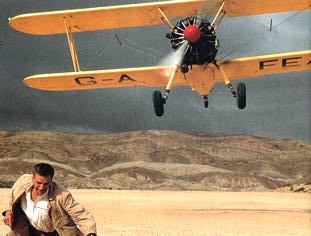 BEHIND THE SCENES
BEHIND THE SCENES
Once
Minghella completed his screenplay, and after Zaentz had begun assembling
the finances for the film which included a considerable amount of his own
money, the crucial task of casting was begun.
In early 1994, the
script was sent to Ralph Fiennes who, as soon as he read it, committed
himself to play the role of Count Laszlo Almásy. Minghella says
of Fiennes, "He's immensely intelligent and has great emotional complexity.
He can play a chord which, however sweet, contains the threat of discord.
Juliette Binoche is the opposite. You have a direct route to her
soul when she's working and her soul is full of joy."
"When Saul and
Anthony talked to me about the film I read the book and felt I understood
Hana," says Binoche. "But when I film, I never plan anything
because I never know how a scene will be. Only when I'm talking before
the cameras or touching another character, then it becomes real and I can
say that I understand the truth of what is happening."
For the role of Katharine
Clifton, the elegant upper class British wife who falls in love with Almásy,
Minghella cast the Kristin Scott Thomas. "Kristin's screen
presence has true stillness and she has elegance and poise which underpin
Katharine's unvarnished candor and which seem to belong to another age,"
the director says. "I never felt quite so strongly about any role
before and I can't exactly say why," Scott Thomas says. "I actually
wrote to Anthony when I heard he was making the film and asked to meet
him."
 Colin
Firth rounds out the principal cast in the role of Katharine's husband
Geoffrey Clifton. Clifton is a bright and charming enthusiast, with a genuine
love of the desert and of flying. Recruited by the British Government to
obtain aerial maps for the whole region in the event of the impending war
spreading to North Africa, Clifton is a decent man made mad by his discovery
that Katharine is in love with Almásy. "Colin's an exceptional
actor, one of the best of his generation," Minghella says. "Like
Ralph he's a highly intelligent and adroit player and has in common with
him an emotional rigor. In fact the whole company of actors from diverse
backgrounds and nationalities shares the same insistence of emotional rigor.
None of them will cheat and in such turbulent material that integrity is
vital." Colin
Firth rounds out the principal cast in the role of Katharine's husband
Geoffrey Clifton. Clifton is a bright and charming enthusiast, with a genuine
love of the desert and of flying. Recruited by the British Government to
obtain aerial maps for the whole region in the event of the impending war
spreading to North Africa, Clifton is a decent man made mad by his discovery
that Katharine is in love with Almásy. "Colin's an exceptional
actor, one of the best of his generation," Minghella says. "Like
Ralph he's a highly intelligent and adroit player and has in common with
him an emotional rigor. In fact the whole company of actors from diverse
backgrounds and nationalities shares the same insistence of emotional rigor.
None of them will cheat and in such turbulent material that integrity is
vital."
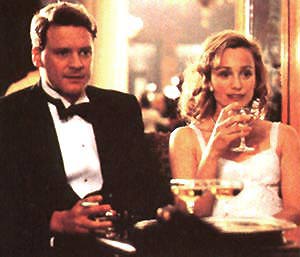
LOCATIONS
Rome and Tuscany Principal photography began on September 4, 1995.
After three weeks of filming at Cinecitta, the company moved to the town
of Pienza in Tuscany to film scenes which take place in and around the
Monastero di Sant'Anna. They then moved on to Viareggio, a coastal resort
town near Pisa, to create the emergency field hospital triage tent. The
scenes that take place in Cairo's famed Shepheard's Hotel [right] were
filmed in the Hotel des Bains on the Venice Lido. Filming began there in
early November 1995. That the incomparable city of Venice was standing
in for Cairo took on a special significance for many involved in the production.
"In Italo Calvino's book Invisible Cities, he describes one
city which is a town that can only be approached by sea and when you get
there it's a desert," says Michael Ondaatje. "And that's how
Venice was for us".
"Tunisia was
the perfect place for us to shoot Cairo and the desert," Stuart Craig
says. "Shooting on that location we were able to get the stunning
visuals without any special effects."
"This was very
important," Minghella explains. "There are three distinct time
frames and locations in the film - Italy, Cairo, and the desert and the
more separate and distinct these three images are visually, the more everyone
has a better sense of where the action is without thinking about it. The
greens and blacks they used in Italy contrast sharply with the palette
of golden hues they created for the desert."
On November 13, 1995
the company flew from Venice to North Africa where, for 9 weeks, the remaining
scenes were shot.
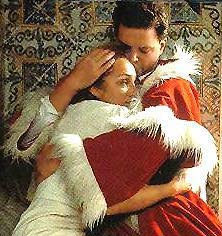 The
British Ambassador's residence in Cairo were photographed in a spacious,
unoccupied former foreign minister's private residence in Tunis, built
nearly 150 years ago. "We chose this one," recalls Craig, "for
the authentic Islamic elements in its architecture and design, its elegant
arches and beautiful ceramic work. We also liked the central open courtyard
around which the house was constructed. It projected the proper interior/exterior
ambiance, a sense that the very streets of Cairo permeate the Ambassador's
residence. The
British Ambassador's residence in Cairo were photographed in a spacious,
unoccupied former foreign minister's private residence in Tunis, built
nearly 150 years ago. "We chose this one," recalls Craig, "for
the authentic Islamic elements in its architecture and design, its elegant
arches and beautiful ceramic work. We also liked the central open courtyard
around which the house was constructed. It projected the proper interior/exterior
ambiance, a sense that the very streets of Cairo permeate the Ambassador's
residence.
Filming the Christmas
party [left] during grueling heat in this exotic residence made it seem
all the more incongruous, adding in a way to the sense that the characters
are at odds with their environment and somehow adrift."
The sequences of
Katharine and Almásy strolling through the narrow, winding alleyways
of Cairo's Medina were filmed in a souk in Sfax. After filming in Sfax,
the unit traveled to the Mediterranean town of El Mahdia, which doubled
for Tobruk.
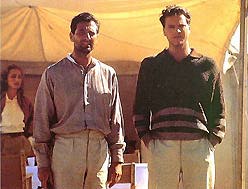 For
centuries Tozeur has been a staging point for Bedouin caravans en route
from the desert to the Mediterranean coast in the north. It was in the
environs of Tozeur that the production found oases and a variety of desert
landscapes crucial for the film's narrative. One important location, 45
km from Tozeur, was the vast, dry salt lake called the Chott el Jerid which
served as the Almásy-Madox expedition's base camp. Another was the
undulating Sahara sand dunes close to the Chott. Littered with furrows
made by the desert winds, the dunes look as if they have existed undisturbed
forever. For
centuries Tozeur has been a staging point for Bedouin caravans en route
from the desert to the Mediterranean coast in the north. It was in the
environs of Tozeur that the production found oases and a variety of desert
landscapes crucial for the film's narrative. One important location, 45
km from Tozeur, was the vast, dry salt lake called the Chott el Jerid which
served as the Almásy-Madox expedition's base camp. Another was the
undulating Sahara sand dunes close to the Chott. Littered with furrows
made by the desert winds, the dunes look as if they have existed undisturbed
forever.
COSTUMES
Ann Roth, who selected and supervised the creation of all the costumes,
also made a significant contribution to the recreation of the period. "In
1938, the Duke of Windsor was the trend-setter for the upper crust English,
so we had the dinner clothes the men wear made on Saville Row by the Duke's
tailor, a man named Mr. Halsey. He had dressed the Duke when he was King.
Mr. Halsey also made clothes for many movie stars in the 1930's."
The military clothing used in the film is also authentic. "British
and Canadian uniforms were made by a company called Nathans. After the
war they were purchased by the costume house of Angels Berman who provided
us with them for the film. The marvelous thing is that the uniforms the
soldiers and nurses are wearing are real." [Click
here for the full text at the Classical In Sites]
[Pictures
based on photos in Chaplin2/1997, The Mandarine Oriental 3/1997
and the Screenplay]
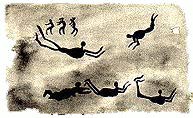
Click
here to try out some sound files at Dolores' page
Click
here to see a video trailer for The English Patient

|

 BEHIND THE SCENES
BEHIND THE SCENES